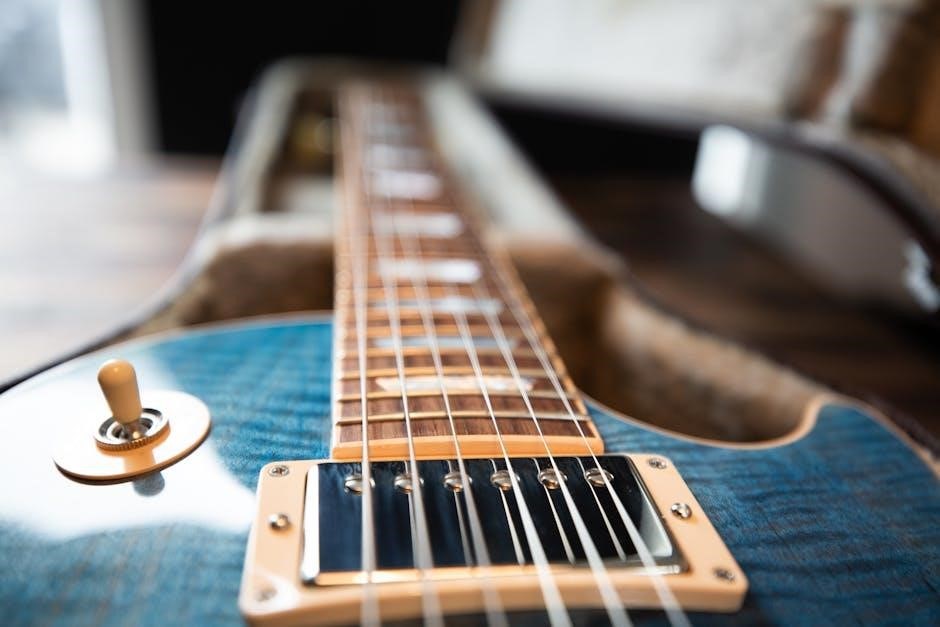Download free guitar practice templates in printable PDF format to enhance practice sessions with organized planning and goal setting using a daily guitar practice routine template effectively online always.
Benefits of a Guitar Practice Schedule
A guitar practice schedule provides numerous benefits to individuals learning to play the guitar, including improved organization and planning of practice sessions. By setting goals and tracking progress, guitar players can ensure they are practicing regularly and effectively, leading to increased motivation and productivity. A practice schedule also helps to prevent aimless noodling, allowing players to focus on specific techniques and skills they want to develop. Additionally, a schedule enables players to allocate time for warm-up exercises, physical technique, and music theory, resulting in a well-rounded practice session. Overall, a guitar practice schedule is an essential tool for anyone looking to improve their guitar playing skills, as it helps to create a structured and efficient practice routine. With a schedule, players can make the most of their practice time and achieve their goals more quickly and effectively. Regular practice leads to consistent improvement.

Creating an Effective Guitar Practice Routine
Effective guitar practice routines involve setting goals and tracking progress using online resources and templates to create a personalized practice schedule always with a clear plan and strategy.
Sample 30-Minute Practice Routine
A sample 30-minute practice routine can be divided into sections to maximize productivity and improvement. The routine can start with a 5-minute warm-up session, followed by 10 minutes of physical technique practice, including scales and arpeggios. The next 10 minutes can be dedicated to applying technique to music and songs, and finally, 5 minutes can be spent on reviewing and setting goals for the next practice session. This routine provides a balanced approach to practice, covering both technical exercises and practical application. By following this structure, guitar players can make the most of their practice time and see noticeable improvement in their skills. The routine can be adjusted to fit individual needs and goals, and can be used as a starting point for creating a personalized practice schedule. Using a metronome and setting playing goals can also enhance the practice session.

Importance of Warm-up Exercises
Warm-up exercises are essential for guitar practice to prevent injuries and improve flexibility and dexterity in hands and fingers always using online resources effectively.
Hand Stretching and Finger Stretching Exercises
Hand stretching and finger stretching exercises are crucial for guitar players to improve dexterity and flexibility. These exercises can be done before and after practice sessions to prevent injuries and reduce fatigue. Online resources provide various hand and finger stretching exercises that can be incorporated into a daily guitar practice routine. A practice routine template can be used to schedule these exercises and track progress. Finger stretching exercises can help improve finger independence and strength, while hand stretching exercises can help reduce tension and improve overall hand mobility. By incorporating these exercises into a practice routine, guitar players can improve their overall technique and performance. Regular practice and stretching can also help prevent common injuries such as tendonitis and carpal tunnel syndrome. A well-structured practice routine with hand and finger stretching exercises can help guitar players achieve their goals and improve their skills. Regular practice is essential to see improvement.
Physical Technique and Music Theory
Develop physical technique and music theory skills through scales, arpeggios, and exercises to improve overall guitar playing ability effectively online always with a practice routine.
Modules for Right Hand Exercises and Left Hand Techniques
Modules for right hand exercises and left hand techniques are essential components of a guitar practice routine. These modules include various exercises such as alternate picking, classical guitar right hand exercises, and neoclassical picking exercises. The right hand syllabus provides a comprehensive guide to right hand techniques, while the picking exercise worksheet offers a structured approach to improving picking skills. Additionally, modules such as Mauro Guiliani’s 120 right hand studies provide a wealth of material for right hand development. For left hand techniques, modules focus on finger independence, strength, and dexterity, with exercises such as finger stretches and chord shapes. By incorporating these modules into a guitar practice routine, players can improve their overall technique and musicianship. Effective practice routines also include a combination of physical technique and music theory, leading to well-rounded guitar playing. Regular practice with these modules will yield significant improvements in guitar playing ability.

Practice Variables for Maximum Gains
Using a metronome and setting playing goals adds variations to practice routines for maximum gains always with effective tempo changes online.
Using a Metronome and Setting Playing Goals
Using a metronome is an essential tool for guitar players to improve their timing and rhythm, it helps to develop a strong sense of tempo and timing. Setting playing goals is also crucial, as it provides a clear direction and motivation for practice sessions. With a metronome, players can practice scales, arpeggios, and other exercises at a consistent tempo, which helps to build speed and accuracy. By setting specific goals, such as increasing speed or mastering a difficult piece, players can track their progress and stay motivated. Additionally, using a metronome and setting playing goals can help to avoid aimless noodling and ensure that practice time is used efficiently. It is recommended to use a metronome regularly and set achievable goals to maximize progress and improvement in guitar playing. This approach can be applied to various aspects of guitar playing, including technique, music theory, and repertoire building.

